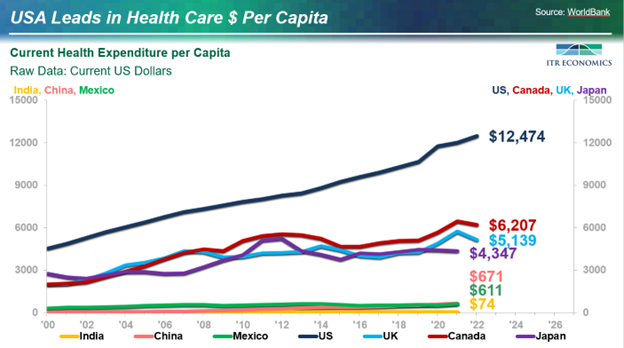As the healthcare industry approaches the 2030s economic depression, it is grappling with a multitude of challenges that threaten to reshape and redefine the landscape of patient care. From the escalating costs of medical technologies, labor, and treatments to the pressing need for healthcare accessibility as the global population ages, the sector faces an array of obstacles. Addressing these challenges will be crucial to ensure that healthcare remains effective and available.
Rising Healthcare Costs for Patients
Healthcare costs are rising for patients, though such costs can be obscured by the third-party payer system. We anticipate the broader pricing environment will be characterized by disinflation – i.e., a slowing rate of rise in prices – into mid-2025. Inflation will then heat up through at least 2026.
Making a tricky situation worse, the US leads the rest of the world in healthcare expenditures per capita by a significant margin.

With Americans spending the most on health expenditures and costs rising, what could the future bring? There could come a time when patients begin to reject the cost of health issues. This could be something relatively minor, such as skipping a doctor visit and riding out a sickness, or it could be something more extreme, such as opting to not move forward with a more advanced cancer treatment because of the burden of financial challenges.
Post-COVID Normalization
COVID-19 changed the world as we know it. There was a strong need for medical professionals to mitigate the impact of COVID-19, but at the same time numerous patients avoided their regular appointments and checkups.
Once the world started to return to some form of normalcy in the wake of the pandemic, patients returned to their normal checkups in droves in 2021 and 2022. This wave of patient care brought growth to the sector.
Now, heading into 2025, the healthcare field is slowing down but still normalizing from the pandemic time period.
Cost Increases: Labor, Technology, and AI
Costs are not only increasing for consumers, but also for healthcare businesses. Labor is a major cost.
Labor constraints have been a difficult hurdle for numerous businesses so far in the 2020s, and it is expected that they will be a factor for the rest of the decade leading to the 2030s depression. Now more than ever, healthcare businesses have to pay even more to attract personnel such as doctors and nurses.
With an aging population necessitating a significant increase in healthcare facilities and supplies, the healthcare sector will have to pay competitive wages not only to attract workers, but also to keep staff happy and support retention.
As technology advances, the cost of new medical equipment and supplies could also be a concern for healthcare businesses. And while AI could be a great investment for many hospitals and medical facilities, investing too much into AI without a well-developed plan for the technology could be detrimental.
Cyber Security
While AI could increase productivity, it also introduces new risks – it makes cyber security a bigger threat than ever, with more ways to trick employees, such as AI-written emails or AI-replicated speech from a familiar voice.
With so much vital data stored within medical facilities, the healthcare industry could be an easy target for hackers looking for sensitive information. Additional time, money, and effort will have to go into training employees to improve their “human firewall” skills and stop any potential threats.
On a Positive Note...
On the bright side for the industry, the baby boomer population will need more and more healthcare resources as the years progress. Rising demand for medical care could open opportunities across the services, manufacturing, and construction industries.
For those currently in or soon entering college, the medical field will offer some of the more secure and profitable career choices during the 2030s, and the industry will need these workers.
Hospital construction spending, which we analyze and forecast in the ITR Economics Trends Report™, is expected to undergo a very mild dip in the first half of 2025 and then rise through at least 2026.
The healthcare field will have major opportunities leading up to and through the 2030s depression, but that does not mean there will not be challenges along the way. To help your business prepare for the years leading up to the 2030s and to learn how to prosper through the coming depression, contact us at ITR Economics!